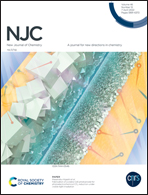Microwave-assisted synthesis of ZnGa2−x−yEuxTbyO4 luminescent nanoparticles showing balanced white-light emission
Abstract
Phosphor-converted white-light-emitting diodes (pc-WLEDs) are technologically advanced next-generation lighting sources, which will potentially substitute traditional lighting. Herein, we report microwave-assisted synthesis of single-phase ZnGa2−x−yEuxTbyO4 nanophosphors in 10 min with high yields (>90%) at a low temperature of 200 °C. The structural and optical properties of the ZnGa2−x−yEuxTbyO4 were studied by XRD, HR-TEM, FT-IR, diffuse reflectance, and photoluminescence (PL) spectroscopy. Annealing improved the crystallinity, and the emission colour shifted from blue to the balanced white light region. The CIE coordinates confirmed that the 800 °C annealing is suitable to get balanced white light. Tb3+-to-Eu3+energy transfer is demonstrated by varying the doping concentrations. Balanced white light was achieved by tuning the emission color of ZnGa2−x−yEuxTbyO4 with optimized Tb3+ and Eu3+ doping. ZnGa1.975Eu0.01Tb0.015O4 annealed at 800 °C showed balanced white light with CIE coordinates (x, y) = (0.32, 0.33), colour temperature Tcp = 5975 K and average colour rendering index (CRI) Ra = 90. These values suggest that the 800 °C-annealed ZnGa1.975Eu0.01Tb0.015O4 is a competitive phosphor for the generation of white light with good colour reproducibility.



 Please wait while we load your content...
Please wait while we load your content...